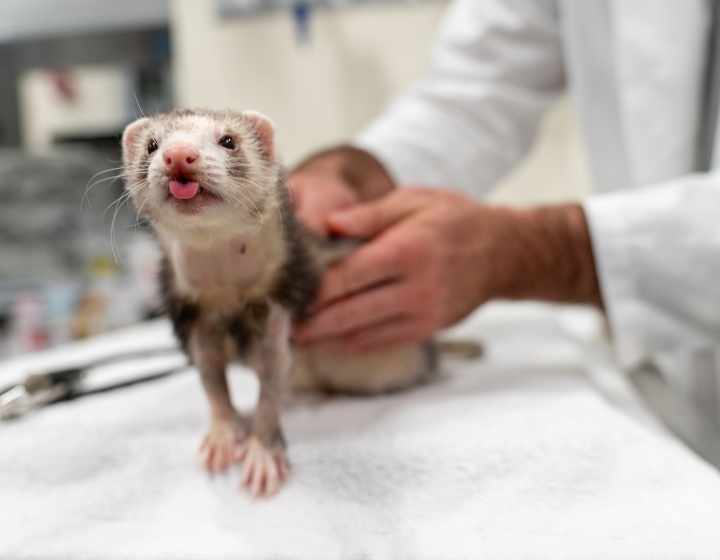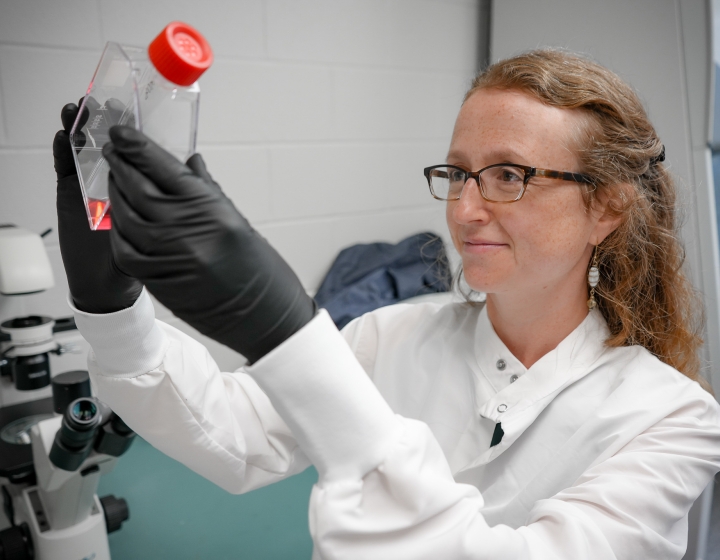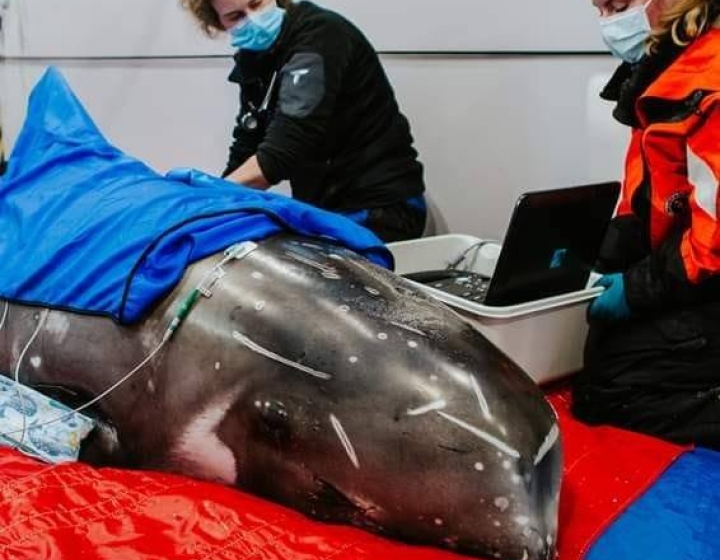New faculty profile: Dr. Erin Scott
The Cornell University College of Veterinary Medicine (CVM) has recently welcomed many new faculty members to our academic departments, each one bringing a unique set of skills and experience that enriches our college every day. In this Q&A series, you'll get to know their interests, expertise and more.
Dr. Erin Scott is an associate professor of ophthalmology in the Department of Clinical Sciences. She is the second faculty member supported by the Cornell Richard P. Riney Canine Health Center, where her research on eye tissues and diseases will play a critical role in helping dogs live longer, healthier, happier lives.
Q: What has been your academic/career path leading up to Cornell?
A: I graduated from the University of Pennsylvania School of Veterinary Medicine in 2010 and completed a rotating internship in companion animal medicine and surgery at Louisiana State University. Beginning in 2011, I pursued a fellowship in comparative ocular pathology as well as a residency in comparative ophthalmology at the University of Wisconsin — Madison.
Following my residency training, I joined the faculty at Texas A&M University for seven years. During this period, my focus concentrated on building a new comparative ophthalmology service, developing a research career, and incorporating ophthalmology lectures and clinical skills training into their veterinary curriculum.
Q: What drew you to CVM?
A: The longstanding exceptional reputation of the ophthalmology service, opportunities for research collaborations both within and among departments, and the college’s dedication to high standards of education drew me to CVM.
Q: What is your clinical area of expertise?
A: As a veterinary ophthalmologist, my professional interests are broadened by the wide variety of clinically relevant ocular conditions encountered in our patients. This includes advancements in the treatment of cataracts and glaucoma, comparative ocular pathology, and the ocular surface microbiome in health and disease.
Q: What drew you into this area? Any specific experiences, mentors or influences that helped guide you?
A: I had wonderful mentorship in my early career from Dr. William Beltran, professor of ophthalmology at the University of Pennsylvania and former graduate of Cornell’s Baker Institute for Animal Health, as well as Dr. Richard Dubielzig, professor emeritus of comparative ocular pathology at the University of Wisconsin — Madison. Both mentors inspired me to pursue a career in academia where I could combine my skills as a clinician, researcher and teacher.
Q: What past professional work are you most proud of and why?
A: I had the unique opportunity to co-create an essential specialty service within a teaching hospital that had been absent for several years. To meet the needs of the college and local community, I co-designed and developed the comparative ophthalmology service at Texas A&M University with Dr. Lucien Vallone, a former ophthalmology resident at Cornell Vet. I am most proud of our teamwork to build a productive de novo academic medical service and successful ophthalmology residency training program.
Q: What about your work are you most excited about or proud of, and why?
A: Little is known about the ocular surface microbiome and its impact on disease. My work is the first in our field to investigate the temporal stability of the ocular surface microbiome before and after topical antibiotic administration in cats, dogs and horses.
Using molecular based techniques, we identified diverse, species-rich bacterial and fungal communities on the healthy ocular surface, challenging the dogma of a relatively sterile ocular environment in ophthalmic research. All eyes demonstrated the presence of microbes, many of which were previously unassociated with the eye. A stable core bacterial microbiome was identified and discovered to remain consistent regarding species richness and community structure over time and following antibiotic therapy.
Q: What impacts or applications do you hope to see your work have on the world and human/animal/planetary health?
A: By linking the clinical features of disease with their associated microbial community and pathologic changes, I provide a unique perspective in the interpretation and understanding of ocular disease processes in veterinary patients and their relevance to comparable human disorders.
Q: What scientific questions are you planning to explore next?
A: My future goals at Cornell are to expand beyond the identification of organisms to evaluate host interactions with the ocular surface microbiome using a protein-based approach (metaproteomics) and metabolite-based approach (metabolomics) to further expand our understanding of the microbiome and its impact on human and animal ocular health.
Q: What’s something most people don’t know about you?
A: My husband and I are native Buffalonians and avid Buffalo Bills fans. This might be our year!
Q: What’s the best part of your job?
A: I love the comparative nature of the ophthalmology specialty that allows me to examine the eyes of many different species, both domestic and exotic!
Q: What’s the most challenging part?
A: The most challenging part is also the most exciting. Juggling the responsibilities of clinical practice, research and teaching ensures there is never a dull moment at work!
Q: What are the benefits of working at CVM? At Cornell?
A: I look forward to working with a dedicated, diverse and collaborative community at Cornell.






